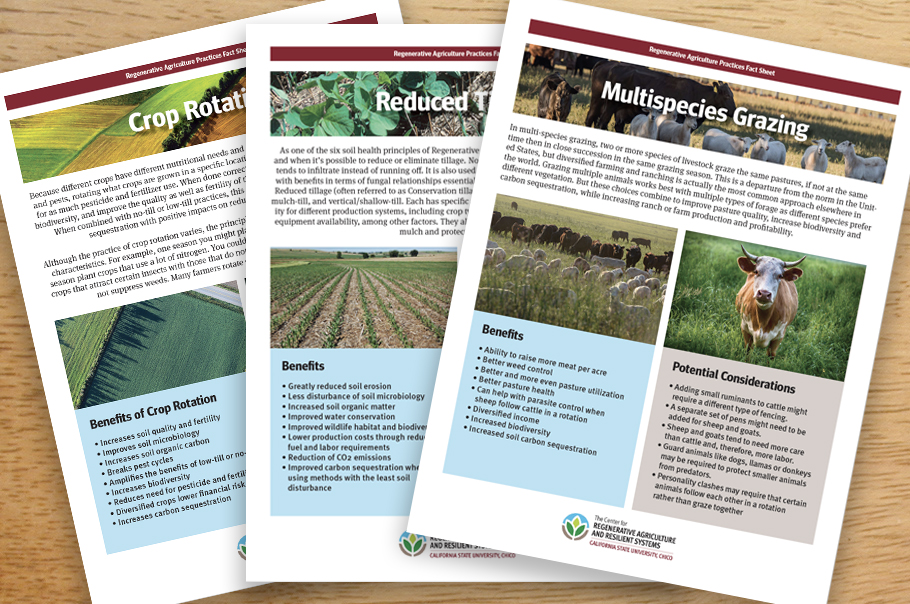
TAP Training Program in Five Elements

- CRARS Professional Course Series Modules
- NRCS AgLearn Courses
- Conservation Activity Plan (CAP) training
- Conservation Practice design and implementation workshops
- CAP development, submittal and review support within multiple categories of certification
A note for those also seeking TSP Certification through NRCS: Select NRCS Aglearn (NRCS's online educational platform) courses will be integrated into the “Holistic Farm/Ranch Planning and Design” course. Through coordinated efforts between NRCS specialists, CRARS and other conservation partners, participants will complete various NRCS courses required for NRCS TSP certification. In-person trainings may be offered throughout the series, however for those unavailable to meet in person, all material will be offered virtually. If participants are interested in becoming NRCS certified TSPs, they will be required to register with NRCS Aglearn, so that NRCS learning modules can be completed. For out of state participants seeking TSP certification in a state other than CA, a few additional steps will need to be taken to transfer credit from California to the planner’s home state. The CRARS TAP Coordinator, Lindsey Hethcote(opens in new window), will be available for ongoing support to TAPs seeking NRCS TSP certification. As an NRCS registered TSP, you will be listed as a TSP on the NRCS registry, and will be able to be contracted by producers for conservation work via an NRCS contract. https://nrcs-sites.secure.force.com/FindaTSP(opens in new window).
Element 1: CRARS Professional Course Series
Conservation Partners pursuing certification would complete core modules from the following three courses and choose additional content appropriate to the specific resource category of interest.
Course #1: Systems Theory and Practice
An introduction to management approaches that focus on the interactions and synergies of ecosystem processes (energy flow, water and nutrient cycles, and community dynamics) to leverage the power of photosynthesis to improve water use efficiency and soil health across a variety of agro-ecosystems using appropriate production practices.
Topics Include:
- Introduction to systems management: challenging paradigms.
- Processes and principles: Introduction to agroecosystems and soil health.
- Minimizing soil disturbance: no-till, strip-till and more.
- The benefits of biomass: cover crops and crop rotation.
- Biological applications: the link between soil, plants, and animals.
- Annual cropping systems (row crop; pasture).
- Perennial cropping systems (rangelands; orchards; vineyards).
- Incorporating and managing livestock through adaptive planned grazing.
- Agroforestry systems (timber and grazing).
- Economic view of systems management: short- and long-term ROI
- Conservation through partnerships: opportunities and engaging effectively
Course #2: Soil Health Systems
Understand the connection between soil health and primary productivity and, ultimately, food and fiber quality. This course will cover soil properties, metrics of soil health, and influences of production practices and soil management systems (integrated practices) on these components. Soil sampling, analysis and interpretation are presented, along with monitoring strategies to ensure on-farm success.
Topics Include:
- Basics of soil health: degradation and restoration.
- Organic matter: the living, the dead, and the very dead part of soil.
- Physical nature of soils: the what, where, and how of soil formation and loss.
- Soils and plants: biological, chemical, and physical property influences on plant health.
- Nutrient management: considering source, rate, time, and place when using livestock and plant waste to build soil health.
- Irrigation technology and management strategies.
- Soil testing and monitoring: what and when.
Course #3: Science & Practice of Ecological Forest and Range Management
Explore two complex and complimentary agro-ecological systems through sustainable management practices. Innovative and practical approaches to livestock grazing, timber production, wildlife habitat, fuels management and other fire prevention and fire recovery strategies for balanced management to support ecosystem and economic resiliency.
Topics Include:
- History, science and policy of forest and rangeland management in the West.
- High functioning ecological processes in well-managed forests: case studies from public and private lands.
- Sustainable rangeland management: case studies from public and private lands.
- Fire resiliency measures, methods & controlled burns in forest and rangeland ecosystems.
- Fire recovery methods for land restoration incl. soil stabilization & improved water quality.
- Grazing systems for working lands: processes, principles and practices.
- Pollinators and wildlife habitat management.
- Applied agroforestry and watershed management planning and design.
- Applied management: sustainable rangeland and ecosystems planning and design.
Course #4: Farm/Ranch Planning and Design
This course supports the transitional process to a plan, implement, monitor, replan management framework that encourages producers and ag professionals to work through a systems lens that addresses economic success and improved land health. Participants will develop a vision that incorporates management goals, establish a land management plan, and identify metrics to quantify outcomes and reassess their plan annually.
Topics Include:
- Managing complex systems: establishing context to set goals with a vision.
- Farm/ranch assessment: resources and inventories from the ground up.
- Tools for enhancing resources within agroecosystems: a review of conservation practices and conservation effects.
- Whole farm/ranch planning: enhancing resources and meeting goals.
- The decision-making process: putting a conservation plan into action.
- The carbon lens: evaluating a farm/ranch plan for GHG reduction and co-benefits.
- Economic evaluation of farm/ranch plan.
- Monitoring for adaptive management.
Element 2: NRCS AgLearn Courses
• TSP Orientation Course
• Conservation Planning Course, Modules 1-6
Element 3: Conservation Activity Plan Training
CAP-specific trainings will be provided through coordinated efforts between NRCS specialists, CRARS and other conservation partners. These offerings will be completed in a combination of virtual and in-person settings, depending on travel and gathering allowances.
Key elements of CAP trainings will be the completion of resource inventory, assessment and evaluation tools; components of each CAP template and applications within CA along with appropriate monitoring strategies for the different resource categories and land use types.
With an increase in the number of conservation partners engaging in providing assistance to farmers, ranchers and non-industrial timber owners, the TAP program, along with the planning opportunity of CAPs, provides a framework for coordinated and thorough assistance that is technically sound and relevant to current landowner needs. We believe the demand for TAP services is rising and having a trained network of community-based TAPs that are certified in multiple resource categories will do much to advance working lands conservation in CA.
Conservation Activity Plans
Forest Management Plan
Determination of forestry-related conservation activities based upon resource inventories and landowner objectives, including forest type, timber and livestock production suitability, wildlife habitat, riparian/wetland resources, soil and air resources.
Grazing Management Plan
Considerations for using livestock to address resource concerns and enhance landscape productivity through timing, intensity and duration of grazing along with logistical factors, including facilitating infrastructure.
Soil Health Management Plan
Determining conservation activities as part of a management system to address soil health concerns and determine enhancement opportunities related to the physical, chemical and biological properties of soil.
Nutrient Management Plan
Integrated nutrient management for productivity and addressing resource concerns and opportunities, in context of growing season, soil type and condition, irrigation, runoff potential, soil biology and other factors.
Fish & Wildlife/ Pollinator Habitat Plan
Incorporating activities into land management systems for the improvement, restoration, enhancement, or expansion of habitat elements that support native and/or managed fish, wildlife, and pollinators.
Carbon Farm Plan
Identifying opportunities and strategies for carbon sequestration and GHG reduction on working landscapes through the Conservation Planning Process using a carbon lens.
Element 4: Conservation Practice Design & Implementation
A series of workshops, planned in coordination with NRCS specialists, hosted by CRARS and partners, and led by producers and planners with experience with each practice will provide additional knowledge-building opportunities on specific conservation practices or sets of practices. These sessions will focus on addressing resource concerns through practice implementation: what, when, where, why and how to install, initiate and maintain practices, along with determining associated and complementary practices based on examples from various regions of CA and site-specific conditions.
Following plan development and practice selection, broader support for practice design and implementation of selected conservation practices will generate improved conservation outcomes and increased likelihood of sustained and expanded practice adoption by producers. A few examples of the content that would be delivered by practice are in the list below.
- Hedgerow establishment: resource concerns being addressed, site preparation, plant selection and spacing, associated practices (e.g. irrigation, mulching, fencing), weed management, maintenance.
- Range planting: resource concerns being addressed, site preparation, seed selection, planting strategy and timing, fencing considerations, when to rest and when to graze, other challenges.
- Cover cropping: resource concerns being addressed, site preparation, seed selection, planting method and timing, irrigation (if necessary), termination method and equipment.
Element 5: CAP Development and Review
Individuals seeking NRCS TSP certification will develop 2 CAPs for review. Plans will need to be submitted for each resource category that certification is being sought for. They will need to meet current CAP criteria, cover two separate locations, and demonstrate understanding of the applicable resource inventory tools, the planning process, addressing resource concerns through appropriate conservation practices and strategies, and working effectively with landowners.
Regenerative Agriculture Fact Sheets

Downloadable fact sheets(opens in new window) on regenerative agriculture practices with links to videos, publications and other resources related to each practice.
